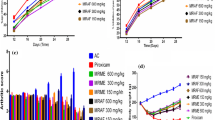Abstract.
Objective and design:
Paeoniae alba Radix has been recognized as a valuable herb in the treatment of rheumatoid arthritis (RA) in traditional Chinese medicine. The purpose of this study was to investigate the effects of Paeoniflorin (PF), a bioactive glucoside from paeony root, on the rats with adjuvants arthritis (AA) and underlying mechanisms.
Materials:
AA was induced by injecting Complete Freund’s adjuvant (10 mg/ml) into hind paw in male Sprague-Dawley rats.
Treatment:
PF (5, 10, 20 mg/kg/d) was orally administered to the rats 14 to 20 days after injection of complete Freund’s adjuvant.
Methods:
Arthritis was evaluated by hind paw swelling, polyarthritis index, immune organ weights, and histological examination. Interleukin-1 (IL-1) activity was assessed by thymocyte proliferation as quantified by the 3-(4, 5-2dimethylthiazal- 2yl) 2,5-diphenyltetrazoliumbromide (MTT) assay. The content of prostaglandin E2 (PGE2) was measured by radioimmunoassay. The levels of IL-6, granulocyte macrophage colony stimulating factor (GM-CSF) and vascular epidermal growth factor (VEGF) in synovium homogenates were measured by enzyme-linked immuno-absorbent assay (ELISA) respectively. Expression of inhibitory subunits of G protein (G i) and cyclo-oxygenase-2 (COX-2) were detected by Western blotting technique.
Results:
There were significant secondary inflammatory reactions in AA rats, which were accompanied by a decrease in immune organ weights. The administration of PF (10, 20 mg/kg/day, i. g., days 14–20) inhibited the inflammatory response and restored the weight of immune organs of AA rats. Synoviocyte proliferation of AA rats increased significantly, and the levels of IL-1, PGE2, IL-6, VEGF and GM-CSF in synovial homogenates of AA rats were also elevated compared with the normal group. The administration of PF (10, 20 mg/kg/day, i.g., days 14–20) reduced the above changes significantly. Finally, the expression of Gi1, Gi2, Gi3 and COX-2 in synovial homogenates of AA rats were also elevated. The administration of PF reduced Gi expression at doses of 10 and 20 mg/kg and decreased COX-2 expression at a dose of 20 mg/kg.
Conclusion:
PF suppresses rat AA at least partly by inhibiting abnormal proliferation of synoviocytes and the production of IL-1, PGE2, IL-6, VEGF and GM-CSF by synoviocytes and reducing Gi and COX-2 expression in synovium.
Similar content being viewed by others
Author information
Authors and Affiliations
Corresponding author
Additional information
Received 3 January 2006; returned for revision 22 May 2006; returned for final revision 23 August 2006; accepted by M. Parnham 8 November 2006
Rights and permissions
About this article
Cite this article
Zheng, YQ., Wei, W., Zhu, L. et al. Effects and mechanisms of Paeoniflorin, a bioactive glucoside from paeony root, on adjuvant arthritis in rats. Inflamm. res. 56, 182–188 (2007). https://doi.org/10.1007/s00011-006-6002-5
Issue Date:
DOI: https://doi.org/10.1007/s00011-006-6002-5




